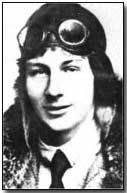Who's Who - Anton Fokker
 Anton Fokker's (1890-1939) name is
inextricably linked with the series of aircraft he designed and which,
employed by the Germans during World War One, came to personify the era of
aerial 'dogfights'.
Anton Fokker's (1890-1939) name is
inextricably linked with the series of aircraft he designed and which,
employed by the Germans during World War One, came to personify the era of
aerial 'dogfights'.
Born in Kediri, Java, Fokker built his first aircraft in 1910 at the age of just 20, thereby teaching himself how to fly. Two years later he established his own small aircraft factory sited in Wiesbaden.
His first aircraft, Spin I, was produced in 1910, but was able only to manage 100 yard flights. Its successor, Spin II, was similarly unsuccessful the following year. It was the 'plane's third incarnation, Spin III, that proved a success, and it was this model that initially interested the German authorities in 1913.
With war declared in August 1914 Fokker offered his services to both sides; the Allies declined but the Germans saw the potential of domination of the skies. Consequently his aircraft company rapidly grew as orders continued to grow; he subsequently took out German citizenship.
Among the successful biplane and triplane designs produced by Fokker during the war was the D-VII, developed in 1917 with the assistance of advice from Manfred von Richthofen (the 'Red Baron'). The D-VII, which went into service on the Western Front in April 1918, proved stronger and faster than the Allied machines in use at that time.
Fokker's company also invented the so-called 'interrupter gear' that made it possible for a machine gun to fire through the aircraft's propeller blades. Fokker's development of the interrupter gear pre-empted French efforts led by Roland Garros along similar lines (the French however had concentrated upon the development of deflector blades).
This device initially gave German pilots a significant advantage over their Allied counterparts when attached to Fokker 'E' aircraft, while the latter's governments scrambled to develop an equivalent mechanism (the Airco DH2 and the Nieuport 17).
With war over Fokker turned to the development of commercial aircraft, this time in Holland. During the 1920s he sold aircraft based upon the D-VII to the Dutch air force.
Fokker moved to the United States in 1922, and was later naturalised. He served for a period as president of the Fokker Aircraft Corporation of America. He died in 1939.
The German word "U-Boat" was derived from "Unterseeboot" (undersea boat).
- Did you know?
